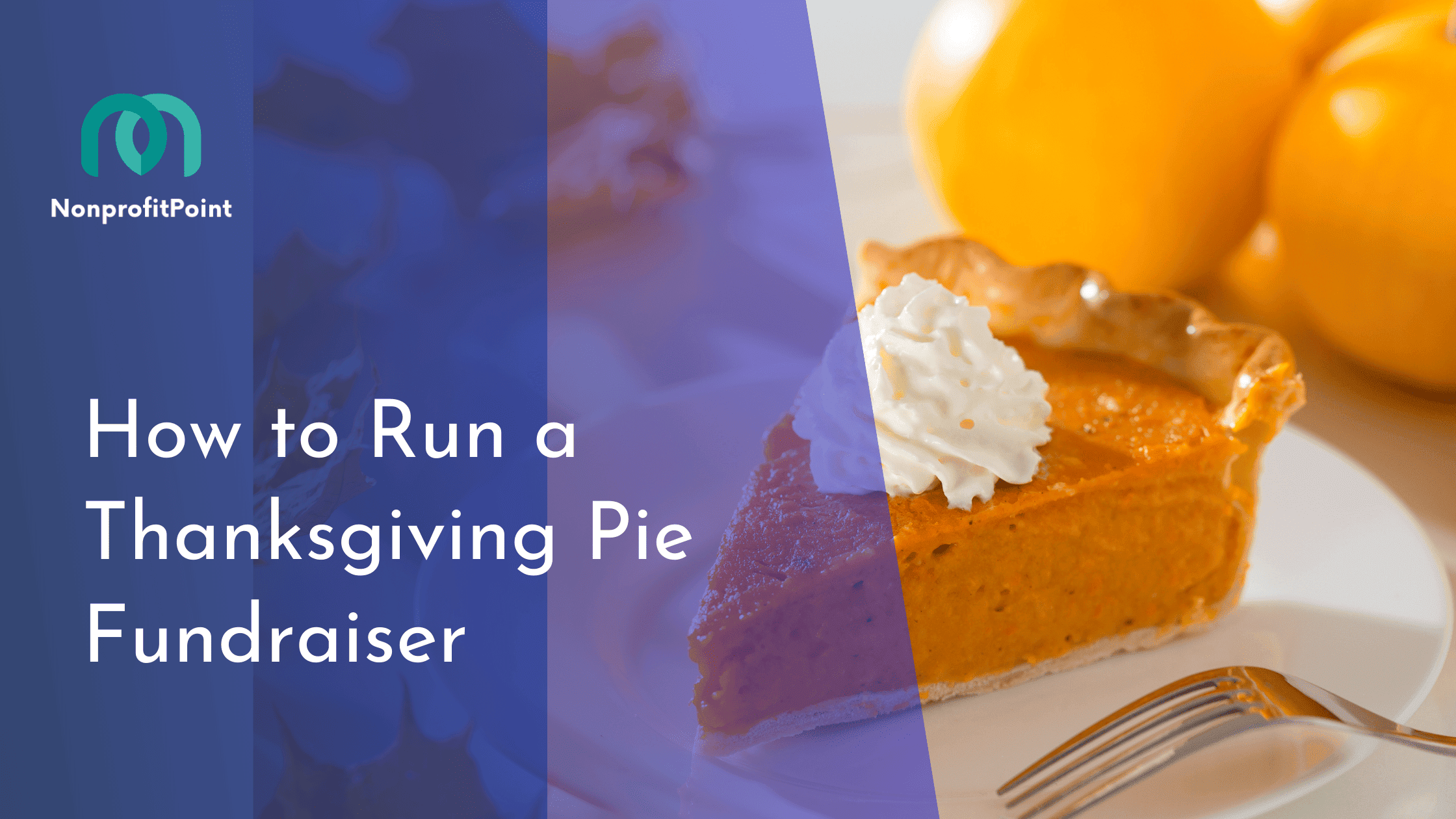How to Run a Thanksgiving Pie Fundraiser For Your School and Community in 10-Steps
As the golden leaves of autumn pave our streets and the air is filled with the comforting scent of cinnamon and nutmeg, schools and communities across the nation find themselves amidst the season of giving. And what better way to encapsulate the heart of Thanksgiving than with a delectable, flaky pie that brings to mind cherished memories of family gatherings?
Welcome to the delightful world of pie fundraisers! For schools and organizations, a pie fundraiser during Thanksgiving isn’t just a way to raise crucial funds, but it’s also a golden opportunity to strengthen community bonds and celebrate a time-honored tradition.
So, if the idea of combining your love for mouthwatering pies with a noble cause has you intrigued, you’re in for a treat. Let’s dive into the delicious details of running a successful Thanksgiving pie fundraiser.
Here’s a 10-step guide on how to run a Thanksgiving pie fundraiser for your school:
1. Planning and Research
Embarking on a Thanksgiving pie fundraiser, or any fundraiser for that matter, without a solid plan is like baking a pie without a recipe. The first step is to crystallize your objectives. Why are you raising funds? Is it for a school project, new equipment, or perhaps a community cause? Determining your exact fundraising goal, both in terms of the monetary amount and its purpose, will offer direction and motivation for everyone involved.
Once that’s set, it’s time for some market research. You might love the idea of a spiced pumpkin pie, but will the community prefer apple or pecan? Conducting a survey, either online or in person, can provide invaluable insights into the community’s pie preferences.
It’s essential to gauge the potential demand and ensure you’re meeting the tastes of your audience. Remember, the more aligned your offerings are with what people want, the more successful your fundraiser is likely to be.
2. Resource Gathering
Once you’ve painted a clear picture of what your community craves, the next step is to gather the necessary resources to bring those delectable pie dreams to life. If you’re venturing into making the pies in-house, you’ll need to identify reliable suppliers for ingredients.
This might be a local grocery wholesaler or even farms that can offer fresh produce directly. Collaborating with local businesses can be a win-win, as they get exposure and you get quality ingredients, sometimes at a more affordable price. If you decide to sidestep the baking process, partnering with a local bakery can be a lucrative option.
Many bakeries might be willing to offer pies at a discounted rate for a good cause, especially if they understand the positive publicity they stand to gain. Beyond the pies themselves, think about your sale venue.
Where will you sell these pies? Will it be a pop-up stall at the school, a booth at a local market, or perhaps an online sale with scheduled pickups? The venue should be accessible to your target audience and spacious enough to accommodate your pies and the expected foot traffic.
3. Team Building
A successful fundraiser is often the result of a cohesive team working together, each member bringing their own unique set of skills to the table. Assembling a dedicated team is paramount.
Start by recruiting volunteers—be it enthusiastic students, supportive parents, or faculty members. Once you have your team, segment them into specialized groups. One could be in charge of baking, mastering the art of the perfect crust and flavorful fillings. Another could manage promotions, spreading the word and drumming up excitement.
Yet another could handle the logistics of the sale day. But bringing together a team isn’t enough; they need to be equipped with the right information and tools. Conduct training sessions where necessary.
If you have people baking pies, they should be well-versed in the recipes and uphold the highest standards of hygiene. Similarly, your sales team should be knowledgeable about the pies and the cause behind the fundraiser, ready to answer any questions potential buyers might have.
4. Promotion
In today’s digital age, the success of a fundraiser can often hinge on its promotion strategy. And for something as tantalizing as a pie fundraiser, the right promotion can make a significant difference.
Begin with traditional marketing materials—eye-catching flyers that make mouths water, posters strategically placed in high-traffic areas, and perhaps even local newspaper ads if the budget allows. But don’t stop at the tangible. Dive into the realm of social media.
Schools often have dedicated social media pages or platforms where parents and students frequently engage. Share tantalizing images of pies, behind-the-scenes peeks into the baking process, and even testimonials from those who have tasted and loved your offerings.
Countdown posts leading up to the sale day can build anticipation. Engage your audience by conducting pie flavor polls or sharing fun pie facts. The aim is to create a buzz, making your Thanksgiving pie fundraiser the talk of the town (or at least the school!).
5. Pie Production
The heart of a Thanksgiving pie fundraiser lies in its main attraction: the pies themselves. The production phase is a delicate ballet of timing, precision, and dedication.
First, you must finalize a baking schedule, especially if you’re making the pies in-house. Pies should be as fresh as possible, so strategize on when each pie type will be baked to optimize freshness while managing the demands of oven space and ingredient availability.
Safety and hygiene are paramount, so ensure all volunteers adhere to cleanliness standards. It’s also a good idea to consider dietary restrictions and allergies. Offering a few special options, like gluten-free or nut-free pies, can broaden your customer base and make everyone feel included.
Quality control can’t be stressed enough. It’s not just about tantalizing flavors but also about consistency. Every apple pie, for instance, should taste equally delightful, ensuring that word-of-mouth recommendations work in your favor and that supporters feel they’ve received value for their contribution.
6. Pricing Strategy
Determining the perfect price point for your pies can feel like threading a needle. Price them too high, and you might deter potential buyers; price them too low, and you risk not meeting your fundraising goals. Begin by conducting a thorough cost analysis.
Factor in the expenses of ingredients, any venue rental costs, marketing materials, and any other associated costs. Once you have a clear understanding of how much each pie costs to produce, you can then mark up that cost to ensure you cover all expenses while raising the desired funds.
But remember, while profitability is essential, the essence of a fundraiser is its cause. So, your pricing strategy should strike a balance between ensuring your school or organization benefits and offering genuine value to your supporters.
Transparency can also be beneficial; letting your community know where the funds will go and how their contribution (via buying a pie) makes a difference can make them more likely to support and even pay a premium.
7. Sale Day Preparation
The sale day is the crescendo of all your meticulous planning and hard work, so ensuring you’re fully prepared is crucial. Begin with logistical considerations: how will the pies be displayed to attract and entice passersby? Will you need tents or canopies if the sale is outdoors?
Tables and chairs for displaying pies and managing transactions? What about a cash box or a digital payment system to facilitate sales? Keep in mind the freshness of the pies — consider investing in coolers or warming equipment depending on the type of pie and the weather.
Signage is another pivotal aspect. Clear and vibrant signs should indicate the variety of pies available, their prices, and perhaps a little blurb about the ingredients or special features (e.g., “gluten-free”).
It’s also a good idea to include information about the cause of the fundraiser, helping to remind buyers that their delicious purchase is making a positive difference in the community.
8. Hosting the Sale
The moment of truth—hosting the sale. While the pies are undoubtedly the stars, the experience you provide to the customers is equally significant. Engage with those who approach your stall or table. Share anecdotes about the baking process, enlighten them about where the funds will be used, and answer any questions with enthusiasm.
It’s this human interaction, combined with the mouth-watering allure of the pies, that will create lasting memories and potentially turn one-time buyers into annual supporters.
Emphasize health and safety throughout the sale, especially if it’s during a period where specific regulations or guidelines need to be followed. This not only ensures the well-being of all involved but also fosters trust with your patrons.
Remember, every person you interact with isn’t just a customer for the day; they’re a potential advocate for your cause and a future supporter of your endeavors.
9. After the Sale
When the last pie has been sold and the stalls packed away, you might think the fundraiser is complete. However, post-sale activities can be as crucial as the preparations leading up to it. Begin by collecting feedback from both the participants and the customers.
What did they love about the fundraiser? Were there any hiccups or areas of improvement? This feedback isn’t just for reflection but to fine-tune and elevate future fundraisers. Then there’s the important task of showing gratitude.
Thanking your supporters goes a long way in nurturing relationships and ensuring they return for future initiatives. This could be in the form of personalized thank-you notes, shout-outs on social media, or small appreciation events.
Lastly, there’s the matter of funds utilization. Transparency is paramount. Make sure you communicate with your community about how the raised funds are being used. Whether you’re buying new school equipment or supporting a community project, sharing updates and impacts reinforce trust and showcase the tangible results of the collective effort.
10. Document and Reflect
A successful fundraiser, while gratifying, is also a treasure trove of lessons and insights. Take the time to document everything—from strategies and sales figures to unexpected challenges and solutions.
This isn’t just bureaucratic record-keeping; it’s building a blueprint for future successes. As part of this documentation, gather your team for a reflection session. What were the standout moments?
Were there any unforeseen challenges? How did the team overcome them? Were there any standout stars during the fundraiser who deserve special recognition? This process of reflection is invaluable.
Not only does it give everyone a sense of closure, but it also paves the way for even more successful fundraisers in the future. Celebrate the victories, learn from the challenges, and gear up for the next big endeavor!
Here are some helpful tips for running a Thanksgiving pie fundraiser:
- Sample Stations: Consider offering bite-sized samples of a few pie varieties. This way, potential buyers can get a taste before they commit, and it might entice those who are unsure.
- Pie Pre-Orders: Allow supporters to pre-order pies, ensuring they get their favorite flavors without the fear of them selling out.
- Themed Packaging: Invest in Thanksgiving-themed packaging or include a small note with a Thanksgiving message. It adds a personal touch and makes the pies gift-ready.
- Pie Baking Contest: Spice things up by hosting a pie-baking contest alongside the sale. The winning pie could be featured as a special edition at the next fundraiser.
- Incorporate Storytelling: Share stories of past successes from the funds raised or compelling reasons for the current fundraiser. Stories resonate, and people are more likely to support causes they feel emotionally connected to.
- DIY Pie Kits: For those who love baking but want a bit of guidance, offer DIY pie kits with all the ingredients and a recipe.
- Collaborate with Local Celebrities: If you have a local personality or influencer, invite them for a pie-tasting or as a guest baker. Their endorsement can amplify reach and sales.
- Special Editions: Offer limited-edition pies or flavors exclusive to the fundraiser, creating a buzz and exclusivity.
- Inclusive Options: Always have options for those with dietary restrictions, whether it’s vegan pies, gluten-free, or sugar-free.
- Engage Kids: Let students or kids be active sellers. Their enthusiasm can be infectious and can sway many potential buyers.
- Loyalty Cards: For bulk buyers or those who might return, offer a loyalty card where they get a discount or a free pie on their next purchase.
- Interactive Stations: Have a station where kids or adults can add final touches to their pies, like whipped cream toppings or a sprinkle of cinnamon.
- Share Behind-the-scenes: On social media, share behind-the-scenes glimpses of the pie-making process, engaging your audience even before the sale day.
- Feedback Forms: Offer a small discount or a promotional item in exchange for filling out a feedback form. It’s a great way to improve and understand your audience better.
- Collaborate with Other Local Businesses: Get local coffee shops or beverage stalls to set up next to your pie station. A warm drink and a pie can be a delightful combo, driving sales for both.
Remember, while the goal is to raise funds, the essence of the fundraiser lies in community engagement, shared experiences, and the joy of coming together for a cause. Making it interactive, inclusive, and fun can significantly elevate the success of the event.
Final Thoughts
Running a Thanksgiving pie fundraiser is more than just selling pies—it’s about weaving together the threads of community spirit, gratitude, and unity. In an era where digital interactions often overshadow face-to-face connections, such fundraisers serve as gentle reminders of the tangible warmth that exists in our communities.
Each pie becomes a symbol of shared stories, mutual efforts, and the simple joy of giving. As you relish each bite this Thanksgiving, let it not just be a treat for your taste buds, but also a reflection of the collective spirit that baked it. In a world hungry for connection, perhaps the answer lies not in vast, grand gestures, but in sharing humble pies, filled with purpose and passion.






